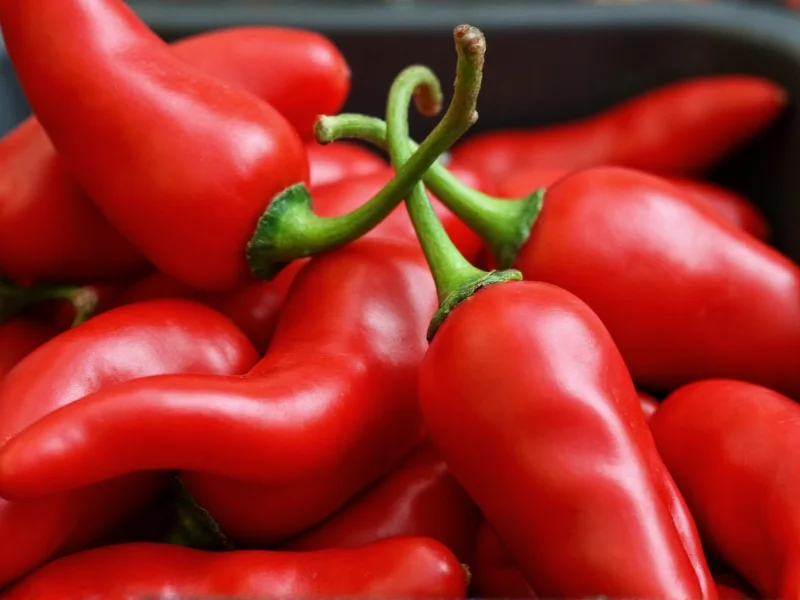For spice enthusiasts and culinary adventurers seeking definitive information about extreme heat levels in peppers, knowing the current scientific record holder provides crucial context. The quest to identify what is the spiciest pepper in the world involves precise scientific measurement, independent verification, and understanding how these peppers compare to more common varieties.
The Science Behind Extreme Pepper Heat
Pepper heat is measured using the Scoville scale, which quantifies the concentration of capsaicinoids—the chemical compounds responsible for that burning sensation. Originally developed by pharmacist Wilbur Scoville in 1912, the Scoville Organoleptic Test involved diluting pepper extract until the heat became undetectable to human testers. Modern laboratories now use High-Performance Liquid Chromatography (HPLC) for precise measurement of capsaicinoid content, then convert these measurements to Scoville Heat Units (SHU) for public understanding.
Understanding what makes a pepper extremely hot requires examining its genetic lineage. Most record-breaking peppers belong to the Capsicum chinense species, which naturally produces higher capsaicin concentrations than other pepper varieties. Selective breeding has amplified these traits, creating peppers with unprecedented heat levels that require special handling protocols.
Pepper X: The Current Record Holder
Officially certified by Guinness World Records in October 2023, Pepper X dethroned the long-standing Carolina Reaper with an average Scoville rating of 2,693,000 SHU. Developed over ten years by Ed Currie of the PuckerButt Pepper Company in South Carolina, this pepper represents the current pinnacle of cultivated capsaicin concentration.
What sets Pepper X apart from previous record holders is its consistent heat measurement across multiple samples. While some peppers might produce occasional extremely hot specimens, Pepper X maintains its extraordinary heat level across harvests. The pepper features a distinctive wrinkled appearance with a pointed tail, typically growing to 2-3 inches in length with coloration ranging from green to vibrant red when mature.
| Pepper Variety | Scoville Heat Units (SHU) | Guinness Recognition | Year Certified |
|---|---|---|---|
| Pepper X | 2,693,000 | World's Hottest Pepper | 2023 |
| Carolina Reaper | 1,641,183 (avg) | World's Hottest Pepper | 2013-2023 |
| Trinidad Moruga Scorpion | 2,009,231 (peak) | Former Contender | N/A |
| Habanero | 100,000-350,000 | Common Hot Pepper | N/A |
| Jalapeño | 2,500-8,000 | Moderate Heat Pepper | N/A |
Verification Process for World's Hottest Pepper Claims
Establishing what is the spiciest pepper in the world requires rigorous scientific validation. Guinness World Records mandates that heat level claims undergo independent laboratory testing using HPLC methodology. Multiple samples from different harvests must demonstrate consistent heat levels before certification.
The verification process for Pepper X involved testing conducted by Winthrop University in South Carolina, where researchers analyzed multiple specimens across several growing seasons. This comprehensive approach ensures the record reflects a stable characteristic of the pepper variety rather than an anomalous single specimen.
Many unofficial claims circulate about peppers surpassing Pepper X, including the Dragon's Breath pepper (reportedly 2.48 million SHU) and the Komodo Dragon pepper. However, without independent verification and Guinness certification, these remain unconfirmed assertions in the scientific community.
Safety Considerations for Extreme Heat Peppers
Handling peppers with Scoville ratings exceeding 1 million SHU requires serious precautions. Capsaicin concentrations at these levels can cause severe skin irritation, respiratory distress, and even temporary neurological effects. Professional growers and handlers use nitrile gloves, eye protection, and respiratory masks when working with these peppers.
Consumption of Pepper X and similar extreme peppers should never be attempted casually. Documented cases show that consuming these peppers can lead to:
- Thunderclap headaches (reversible but extremely painful)
- Severe gastrointestinal distress
- Temporary loss of sensation in the mouth and throat
- Respiratory complications requiring medical attention
If accidental exposure occurs, dairy products (particularly whole milk) provide the most effective relief as casein binds to capsaicin molecules. Water typically worsens the burning sensation as capsaicin is oil-soluble.
Legitimate Culinary Applications
Despite their extreme heat, peppers like Pepper X have legitimate culinary uses beyond novelty challenges. Professional chefs use minute quantities to add complex heat notes to sauces, marinades, and specialty dishes. The key is precise measurement—often just a few granules of powdered Pepper X can transform an entire batch of hot sauce.
Pepper X contributes more than just heat; it offers subtle fruity undertones reminiscent of mango and apricot that balance its intense capsaicin punch. When used appropriately, it creates a layered heat experience that builds gradually rather than delivering an immediate, overwhelming burn.
For home cooks interested in experimenting with extreme peppers, safety protocols are essential:
- Always wear protective gloves when handling
- Work in well-ventilated areas away from children and pets
- Use dedicated cutting boards and utensils
- Start with minuscule amounts (1/16 teaspoon or less)
- Have dairy products readily available for accidental overexposure
The Future of Superhot Peppers
Breeding programs continue to push the boundaries of pepper heat, though safety concerns and diminishing practical applications may eventually limit this pursuit. Researchers are increasingly focusing on developing peppers with unique flavor profiles alongside heat, rather than pure Scoville maximization.
Some scientists are exploring the medical applications of ultra-concentrated capsaicin, particularly for pain management and neurological research. The same compounds that make Pepper X dangerously hot may hold therapeutic potential when properly controlled and administered.
As the search continues for what is the spiciest pepper in the world, the emphasis is shifting toward creating peppers with balanced characteristics rather than pure heat records. Future contenders will likely need to demonstrate both extraordinary heat and distinctive flavor profiles to gain recognition in the competitive superhot pepper market.











 浙公网安备
33010002000092号
浙公网安备
33010002000092号 浙B2-20120091-4
浙B2-20120091-4